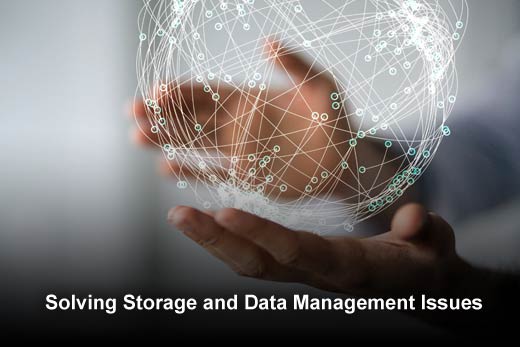When you break down the components of your data center, you realize most have evolved in an effort to avoid the headaches with which they were once associated. Your networking platform is unlikely to introduce new problems into your environment, while your compute system is likely managed via virtualization. However, many of the management issues traditionally rooted in storage remain, especially as companies scale their IT deployments to support their growing businesses.
So, what’s the holdup on the storage front? The answer to such a frustrating question is surprisingly simple. There’s no one-size-fits-all solution for improving data storage – rather, the tactic that fits best with your company is likely as unique as your data itself. Currently, most major vendors are pushing a flash-focused vision for the future of data storage, and, while these strategies have plenty of merit, the investment involved with a flash deployment is unrealistic for any organization looking to scale. That’s not to say flash should be avoided altogether; instead, you should carefully consider how your storage system can best handle data throughout its life cycle and be prepared to adjust as needed to provide new business value for end users.
In this slideshow, ClearSky Data CTO Laz Vekiarides shares five tips to help companies ask the right questions and start solving long-term issues with storage and data management at their core.
Lazarus Vekiarides is the chief technology officer and co-founder of ClearSky Data, a stealth mode startup building a breakthrough enterprise infrastructure solution. Previously, Vekiarides was a member of the core leadership team at EqualLogic and an executive at Dell. He is an expert in data storage, virtualization and networking technologies.
Solving Storage and Data Management Issues
Click through for five tips to help companies ask the right questions and start solving long-term issues with storage and data management, as identified by Laz Vekiarides, ClearSky Data.
Tiered Storage
Listen to your data, and don’t let it ride first class for free.
Data sets run at different intensities, and many can operate optimally even when they’re not relegated to your fastest, most expensive storage tiers. You’ll cut costs and improve system quality when you consider the end-user needs associated with every data set and shift data that isn’t performance-sensitive to less active tiers.
Tiered-storage systems are not yet perfect – today, data can only move between tiers at a slow rate, running the risk of negating benefits by failing to keep up with the speed of data usage. However, you’ll likely run into situations where you need to pull cold data back to high-performance areas of your IT stack. Your storage system should react to performance changes and requirements throughout the data life cycle if you want to avoid bottlenecks and latency issues.
Scaling
Know what you’ll need to effectively scale.
Every company amasses data as it grows, and, whether it’s critical information like intellectual property or employee-generated unstructured data like file versions and emails, this data cannot be compromised. As your company expands, you’ll need to track data usage and provide uninterrupted support for every storage tier to ensure the overall system is properly managed and prepared to scale.
Cost
Track the payoff from your storage performance.
There’s a major price and performance disparity between high-performance flash storage and spinning media. The cost of one gigabyte (GB) of flash storage is staggering when compared with the price of major amounts of disk storage. However, you wouldn’t pay for thousands of cable channels if you were entirely uninterested in watching TV, so why would you pay for excessive storage capacity if it will realistically go to waste? Many organizations find that less than 10 percent of primary data should actually be relegated to hot storage tiers. Track this data and monitor your cost savings as you limit high-performance storage use to your hottest data sets.
Flash Storage
Don’t completely forget about flash – yet.
You already know flash can increase the speed and performance capabilities of your data center, and that it can also break the bank if you’re not careful. However, speed is overvalued in most data centers. Increasing performance and subsequently increasing investments in software, networking and data protection can actually harm other areas of your organization by diverting resources to areas where you aren’t yet ready to make significant improvements. On the other hand, applying flash strategically can increase its return on investment (ROI), delivering results at a higher standard than you may have previously thought possible.
Latency Issues
Consider latency issues in the cloud, as well as on-premise.
More than 50 percent of organizations moved Amazon Web Services (AWS) compute and storage management services back on-premise or to a third-party provider within the last year, according to IDC. It’s not security or control issues that are driving this shift; it’s the latency organizations deal with when they’re moving data between clouds, through complex networks and across major distances. As you launch a new storage deployment, plan for these roadblocks and work with partners who can successfully navigate around them.








